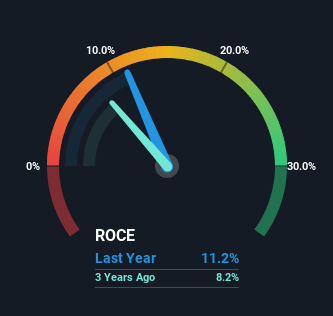Returns On Capital At Budweiser Brewing Company APAC (HKG:1876) Have Hit The Brakes

What are the early trends we should look for to identify a stock that could multiply in value over the long term? Ideally, a business will show two trends; firstly a growing return on capital employed (ROCE) and secondly, an increasing amount of capital employed. This shows us that it's a compounding machine, able to continually reinvest its earnings back into the business and generate higher returns. In light of that, when we looked at Budweiser Brewing Company APAC (HKG:1876) and its ROCE trend, we weren't exactly thrilled.
Return On Capital Employed (ROCE): What Is It?
Just to clarify if you're unsure, ROCE is a metric for evaluating how much pre-tax income (in percentage terms) a company earns on the capital invested in its business. Analysts use this formula to calculate it for Budweiser Brewing Company APAC:
Return on Capital Employed = Earnings Before Interest and Tax (EBIT) ÷ (Total Assets - Current Liabilities)
0.11 = US$1.2b ÷ (US$16b - US$4.4b) (Based on the trailing twelve months to September 2023).
Therefore, Budweiser Brewing Company APAC has an ROCE of 11%. That's a relatively normal return on capital, and it's around the 12% generated by the Beverage industry.
Check out our latest analysis for Budweiser Brewing Company APAC

Above you can see how the current ROCE for Budweiser Brewing Company APAC compares to its prior returns on capital, but there's only so much you can tell from the past. If you'd like, you can check out the forecasts from the analysts covering Budweiser Brewing Company APAC here for free.
What Does the ROCE Trend For Budweiser Brewing Company APAC Tell Us?
There hasn't been much to report for Budweiser Brewing Company APAC's returns and its level of capital employed because both metrics have been steady for the past five years. It's not uncommon to see this when looking at a mature and stable business that isn't re-investing its earnings because it has likely passed that phase of the business cycle. With that in mind, unless investment picks up again in the future, we wouldn't expect Budweiser Brewing Company APAC to be a multi-bagger going forward. This probably explains why Budweiser Brewing Company APAC is paying out 55% of its income to shareholders in the form of dividends. Unless businesses have highly compelling growth opportunities, they'll typically return some money to shareholders.
In Conclusion...
We can conclude that in regards to Budweiser Brewing Company APAC's returns on capital employed and the trends, there isn't much change to report on. And investors appear hesitant that the trends will pick up because the stock has fallen 50% in the last three years. Therefore based on the analysis done in this article, we don't think Budweiser Brewing Company APAC has the makings of a multi-bagger.
While Budweiser Brewing Company APAC doesn't shine too bright in this respect, it's still worth seeing if the company is trading at attractive prices. You can find that out with our FREE intrinsic value estimation on our platform.
While Budweiser Brewing Company APAC isn't earning the highest return, check out this free list of companies that are earning high returns on equity with solid balance sheets.
Valuation is complex, but we're here to simplify it.
Discover if Budweiser Brewing Company APAC might be undervalued or overvalued with our detailed analysis, featuring fair value estimates, potential risks, dividends, insider trades, and its financial condition.
Access Free AnalysisHave feedback on this article? Concerned about the content? Get in touch with us directly. Alternatively, email editorial-team (at) simplywallst.com.
This article by Simply Wall St is general in nature. We provide commentary based on historical data and analyst forecasts only using an unbiased methodology and our articles are not intended to be financial advice. It does not constitute a recommendation to buy or sell any stock, and does not take account of your objectives, or your financial situation. We aim to bring you long-term focused analysis driven by fundamental data. Note that our analysis may not factor in the latest price-sensitive company announcements or qualitative material. Simply Wall St has no position in any stocks mentioned.
About SEHK:1876
Budweiser Brewing Company APAC
An investment holding company, produces, imports, markets, distributes, and sells beer and other non-beer beverages primarily in China, South Korea, India, Vietnam, and the other Asia Pacific regions.
Excellent balance sheet and good value.


